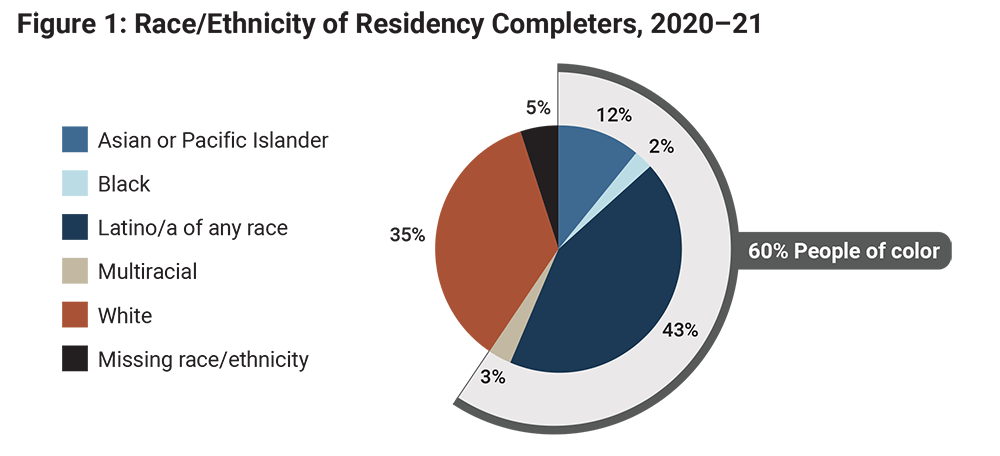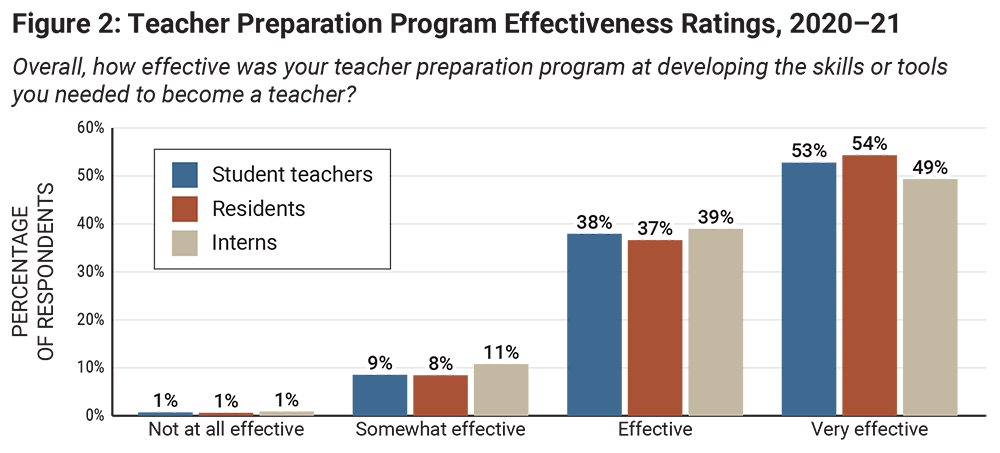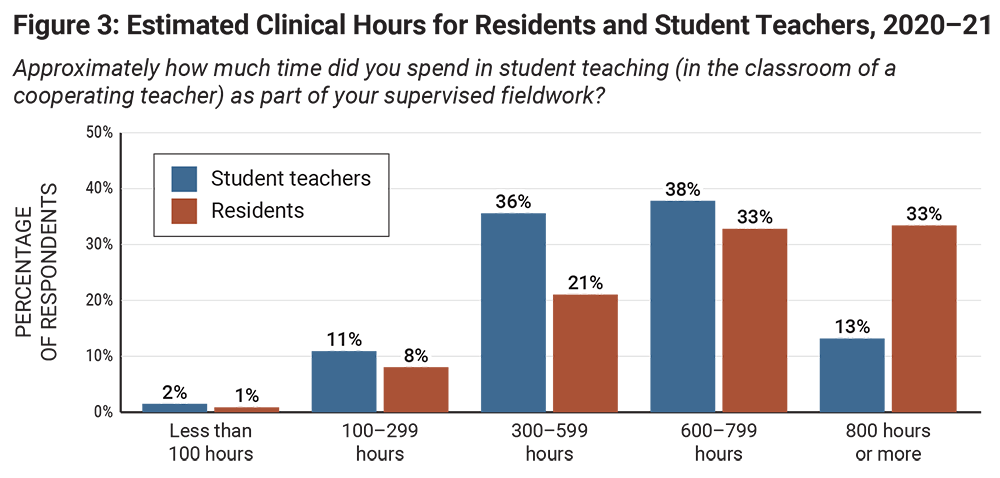Early Impact of Teacher Residencies in California
What are teacher residencies?
Teacher residency programs are developed through a partnership between school districts and teacher preparation programs (TPPs). In these programs, which are modeled on medical residencies, teacher residents work alongside an experienced mentor teacher for a full school year while completing preparation coursework that is tightly integrated with their classroom practice. Residents typically receive financial support during their residency in exchange for a commitment to teach in the sponsoring district upon completion.
Research on the impact of the residency model suggests that graduates of teacher residency programs stay in their districts at much higher rates than those who have entered through other pathways, stabilizing the teaching force, and they are effective, as judged by principals who hire them and evidence about their students’ performance. Research also suggests that, on average, the pool of residents is more racially diverse than new teachers entering through other pathways.Guha, R., Hyler, M. E., & Darling-Hammond, L. (2016). The teacher residency: An innovative model for preparing teachers. Learning Policy Institute; Yun, C., & DeMoss, K. (2020). Sustainable strategies for funding teacher residencies: Lessons from California. Learning Policy Institute.
What has been California’s investment?
In response to widespread teacher shortages, California began making significant investments in teacher residencies in 2018: The legislature allocated $51 million toward residencies in 2018, $350 million in 2021, and $270 million in 2022. These investments are targeted to address high-need fields—including special education; STEM; bilingual education; transitional kindergarten; and, beginning in 2022, counseling. They also are intended to build supply for high-need districts and increase the diversity of the educator workforce.California Commission on Teacher Credentialing. (2022). Teacher Residency Grant Program. California’s investment in teacher residencies—totaling more than $670 million over 5 years—is the largest in the nation. While the implementation process is still in early stages, recent data suggest that California’s teacher residency programs are (1) preparing a significant and growing portion of new teachers in the state, (2) producing graduates who rate their programs as highly effective and as providing more intensive and supportive clinical experiences than other pathways, and (3) helping to increase the diversity of California’s teacher workforce.
What can we learn from surveys of teacher residents?
Since 2016, as completers of California TPPs apply for their preliminary credential, the California Commission on Teacher Credentialing (CTC) has been surveying them to learn about their experiences during teacher preparation. In 2020–21, the CTC’s survey added an option for completers to self-identify as participating in a teacher residency. This analysis examines the 1,226 residency completers in the survey data from 2020–21 and compares them to other completers responding to the survey in the same year. This analysis is limited to residents who attended TPPs that reported running residency programs in the CTC’s accreditation dashboard or TPPs that received residency grants from the CTC.
Residency programs prepare about 1 in 10 new teachers, and about 60% of residency completers are teachers of color.
Of all completers responding to the CTC’s 2020–21 survey, about 1 in 10 identified as a resident. There were 32 TPPs that had at least five completers who identified as a resident, and 72% of residents were from programs in the California State University system. Sixty percent of residents identified as people of color, as shown in Figure 1. In comparison, about 55% of student teaching and internship completers identified as people of color. Just over half of residents (52%) were applying for their multiple subject credential to teach in general elementary classrooms, while 33% were applying for their single subject credential to teach specific subjects in secondary schools and 15% were applying for their education specialist credential to teach students with disabilities.

Source: Learning Policy Institute analysis of CTC Program Completer Survey data (2023).
Residents were more likely to rate their programs as very effective compared to completers from other pathways.
Over 90% of residents rated their preparation program as effective or very effective, as shown in Figure 2. Among completers of different preparation pathways, residents were most likely to rate their program as very effective. Completers were asked about their level of preparedness across the teaching performance expectations aligned with California’s standards for the teaching profession, and more than 75% of residents rated themselves as well or very well prepared for each teaching performance expectation. Residents also had more positive perceptions of their preparation than participants in other pathways in the 2021–22 survey data.

Source: Learning Policy Institute analysis of CTC Program Completer Survey data (2023).
Residency completers reported, on average, more intensive clinical experiences and support than student teachers.
Residents were more likely than student teachers to report sustained student teaching experiences and more frequent clinical support. As shown in Figure 3, residents were more than twice as likely to report having more than 800 hours of student teaching than student teachers in traditional programs. Two thirds of residents (66%) reported at least 600 hours of student teaching, as compared to about half (51%) of student teachers. (Interns typically experience little or no student teaching, and do not answer this question on the CTC survey.)

Source: Learning Policy Institute analysis of CTC Program Completer Survey data (2023).
Likely because of these increased hours, residents were more likely to report higher levels of clinical support (e.g., more observations and instructional feedback) than student teachers. Almost half of residents (47%) reported being observed more than 10 times during their preparation (compared to 33% of student teachers). Residents were also more likely to report receiving high levels of feedback. In our analysis of all completers, the frequency of clinical observation or feedback was strongly associated with completers’ overall feelings of preparedness.
This analysis of recent residency completers’ preparation experiences complements data collected by the CTC on teacher residency grantees, as well as WestEd’s ongoing formative evaluation of California’s teacher residency grant program.White, M. E., Takahashi, S., Hirschboeck, K., Honigsberg, L., Perry, R., … Ambroso, E. (2020). Early learning from formative evaluation of California’s Teacher Residency Grant Program. WestEd. These formative data show that—for the first cohort of grant-funded residents (2019–20 graduates)—91% completed their program and were hired into a full-time teaching position and 88% were teaching 2 years after graduating.WestEd. (2022). California Teacher Residency Grant Program Dashboard. These patterns mirror those found in individual residencies, where retention rates are very high.Guha, R., Hyler, M. E., & Darling-Hammond, L. (2016). The teacher residency: An innovative model for preparing teachers. Learning Policy Institute; Yun, C. (2022). Preparing transitional kindergarten to 3rd grade educators through teacher residencies. Learning Policy Institute; Yun, C., & DeMoss, K. (2020). Sustainable strategies for funding teacher residencies: Lessons from California. Learning Policy Institute. In another Learning Policy Institute study, districts with residencies noted how important these programs were to their ability to recruit and retain teachers during the pandemic.Carver-Thomas, D., Leung, M., & Burns, D. (2021). California teachers and COVID-19: How the pandemic is impacting the teacher workforce. Learning Policy Institute. These encouraging results suggest that many recent completers—and a growing number of districts—have benefited from the state’s expanding residency programs.
Early Impact of Teacher Residencies in California (fact sheet) by Susan Kemper Patrick Linda Darling-Hammond Tara Kini is licensed under a Creative Commons Attribution-NonCommercial 4.0 International License.
This research was supported by the Bill & Melinda Gates Foundation. Core operating support for the Learning Policy Institute is provided by the Heising-Simons Foundation, William and Flora Hewlett Foundation, Raikes Foundation, Sandler Foundation, and MacKenzie Scott.
